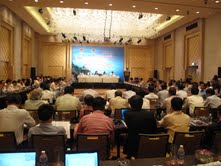Co-chairpersons of the Forum included Ms. Nguyen Thi Kim Ngan, Secretary of the Party Central Committee, Vice Chairman of the National Assembly, Dr. Nguyen Van Giau, Member of the Party Central Committee, Member of the Standing Committee of the National Assembly, Chairman of the National Assembly Committee for Economic Affairs, Prof.Dr. Nguyen Quang Thuan, Vice President of Vietnam Academy of Social Sciences; Ms. Pratibha Mehta, UN Resident Coordinator in Vietnam, UNDP Resident Representative in Vietnam, Mr. Nguyen Tan Tuan, Deputy Standing Secretary of Party Provincial Committee, Chief Congressional Delegation of Khanh Hoa province.
The conference received the attendance of members from National Assembly Committee for Economic Affairs, Committee for Financial and Budget Affairs, Party Central Committee Office, Office of the President, Office of the National Assembly, National Financial Supervisory Commission, Khanh Hoa provincial authorities; the economic and management experts and scientists from Vietnam Academy of Social Sciences, Vietnam Chamber of Commerce and Industry, Central Institute of Economic Management, Development Strategy Institute, General Statistics Office (Ministry of Planning and Investment), National Institute for Finance (Ministry of Finance), Institute of Construction Economics (Ministry of Construction), University of Economics (Vietnam National University), National Economic University, Vietnam Economic Association and various research institutes, universities, Fulbright Economics Teaching Program, and former senior managers of government agencies, National Assembly, Country Director and Chief Economist at the World Bank in Vietnam, UN and UNDP Resident Representatives in Vietnam, Chief Representative of the International Monetary Fund in Vietnam, Chief Economist and Director of the Asian Development Bank in Vietnam, and representatives from a number of commercial banks, State economic groups, State corporations, and the news agencies and the press.
 |
The reviews and comments on 23 presentations at the conference focused on two main themes: (i) Additional evaluation of the performance of the 2012 socio-economic development plan and policy recommendations for the implementation of the 2013 socio-economic development plan: the assessment of Vietnam’s economy in 2012 and policy indications for the 2013 plan; the context of the global economy in 2013; fiscal policy in 2013; restructuring financial market and the effectiveness of monetary policy in Vietnam; trade deficit; balance of payments and foreign exchange reserves; business operations in 2012; estate market; (ii) Restructuring the economy - The Year in Review: economic restructuring; reforming economic institutions; restructuring public investment; restructuring state-owned enterprises, State economic groups, State-owned Corporation 91; commercial banks; bad debts of the commercial banks and economic sectors.
According to Assoc. Prof. Tran Dinh Thien, Director-General of Vietnam Institute of Economics, a number of economic indicators had been improved: a lower inflation rate leading to a significant reduction in interest rates, and the trade balance reversed from a trade deficit of $9 billion in 2011 to a surplus of more than half a billion dollars in 2012. However, the main trend remained negative when the economy in 2012 and early 2013 was in an erratic state at an even more intense level. The key macroeconomic indicators deteriorated: the lowest GDP growth rate in 13 years, a drastic decline in the proportion of social investment to GDP, inflation under control but in a short-term and uncertain state, a great inflation amplitude, and unsolved problems of bad debts and the frozen real estate market.
Some of the first quarter 2013 index of total retail sales and a negative CPI in March indicated a weak demand. A far lower index of industrial production than in 2012 and some very large businesses closed down reflected the bad health of the economy which in turn indicated the uncertain projection for the economic cycle to reach its bottom and recover in the mid-2013. The situation required more specific solutions than conventional solutions. Dr. Thien notified the cost to restore growth and stable economy in the near future and also pointed out the limitations and weaknesses in management and operating, which were considered as causes of instability and declining trust. The solutions proposed therefore would require a priority set to the restoration of confidence in the ability and determination of the government, the stabilization of the macro-economy (with low inflation), and actions to restructure the economy rather than resolve problems. Some crucial remedies suggested by Dr. Thien included: i) An immediate alteration in the management mechanism of interest rate should be done by imposing interest rate caps instead of mobilizing interest rates, ii) bad debts: the role of the State to enterprises’ debts; iii) real estate inventory: the mechanism of the free market itself would settle problem; iv) A priority should be set to restructure selected state corporations,







